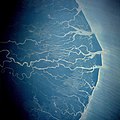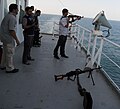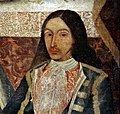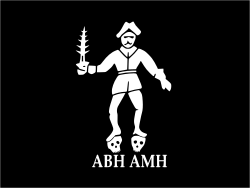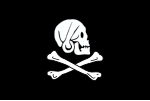Portal:Piracy
Introduction

Piracy is an act of robbery or criminal violence by ship or boat-borne attackers upon another ship or a coastal area, typically with the goal of stealing cargo and other valuable goods. Those who conduct acts of piracy are called pirates, vessels used for piracy are pirate ships. The earliest documented instances of piracy were in the 14th century BC, when the Sea Peoples, a group of ocean raiders, attacked the ships of the Aegean and Mediterranean civilisations. Narrow channels which funnel shipping into predictable routes have long created opportunities for piracy, as well as for privateering and commerce raiding. Historic examples include the waters of Gibraltar, the Strait of Malacca, Madagascar, the Gulf of Aden, and the English Channel, whose geographic structures facilitated pirate attacks. The term piracy generally refers to maritime piracy, although the term has been generalized to refer to acts committed on land, in the air, on computer networks, and (in science fiction), outer space. Piracy usually excludes crimes committed by the perpetrator on their own vessel (e.g. theft), as well as privateering, which implies authorization by a state government.
Piracy or pirating is the name of a specific crime under customary international law and also the name of a number of crimes under the municipal law of a number of states. In the early 21st century, seaborne piracy against transport vessels remains a significant issue (with estimated worldwide losses of US$16 billion per year in 2004), particularly in the waters between the Red Sea and Indian Ocean, off the Somali coast, and also in the Strait of Malacca and Singapore. Modern-day pirates are armed with automatic weapons, such as assault rifles, and machine guns, grenades and rocket propelled grenades. They often use small motorboats to attack and board ships, a tactic that takes advantage of the small number of crew members on modern cargo vessels and transport ships. The international community is facing many challenges in bringing modern pirates to justice, as these attacks often occur in international waters. Nations have used their naval forces to repel and pursue pirates, and some private vessels use armed security guards, high-pressure water cannons, or sound cannons to repel boarders, and use radar to avoid potential threats.
Romanticised accounts of piracy during the Age of Sail have long been a part of Western pop culture. The two-volume A General History of the Pyrates, published in London in 1724, is generally credited with bringing key piratical figures and a semi-accurate description of their milieu in the "Golden Age of Piracy" to the public's imagination. The General History inspired and informed many later fictional depictions of piracy, most notably the novels Treasure Island (1883) and Peter Pan (1911), both of which have been adapted and readapted for stage, film, television, and other media across over a century. More recently, pirates of the "golden age" were further stereotyped and popularized by the Pirates of the Caribbean film franchise, which began in 2003. (Full article...)
Selected biography -
Portrait in the style of Peter Lely, c. 1680 |
Sir Henry Morgan (Welsh: Harri Morgan; c. 1635 – 25 August 1688) was a Welsh privateer, plantation owner, and, later, Lieutenant Governor of Jamaica. From his base in Port Royal, Jamaica, he raided settlements and shipping on the Spanish Main, becoming wealthy as he did so. With the prize money from the raids, he purchased three large sugar plantations on the island.
Much of Morgan's early life is unknown. He was born in an area of Monmouthshire that is now part of the city of Cardiff. It is not known how he made his way to the West Indies, or how he began his career as a privateer. He was probably a member of a group of raiders led by Sir Christopher Myngs in the early 1660s during the Anglo-Spanish War. Morgan became a close friend of Sir Thomas Modyford, the Governor of Jamaica. When diplomatic relations between the Kingdom of England and Spain worsened in 1667, Modyford gave Morgan a letter of marque, a licence to attack and seize Spanish vessels. Morgan subsequently conducted successful and highly lucrative raids on Puerto Principe (now Camagüey in modern Cuba) and Porto Bello (now Portobelo in modern Panama). In 1668, he sailed for Maracaibo and Gibraltar, both on Lake Maracaibo in modern-day Venezuela; he raided both cities and stripped them of their wealth before destroying a large Spanish squadron as he escaped. In 1671, Morgan attacked Panama City, landing on the Caribbean coast and traversing the isthmus before he attacked the city, which was on the Pacific coast. To appease the Spanish, with whom the English had signed a peace treaty, Morgan was arrested and summoned to London in 1672, but was treated as a hero by the general populace and the leading figures of government and royalty, including Charles II. (Full article...)Selected article -
Una Goleta de Guerra Persigue un Barco Pirata, the artwork used to depict the event in Paul G. Miller's Historia de Puerto Rico (1922). |
The capture of the sloop Anne was the result of a naval campaign carried out by an alliance between the Spanish Empire forces in Puerto Rico, the Danish government in Saint Thomas and the United States Navy. The powers pursued Roberto Cofresí's pirate flotilla in March 1825 because of the economic losses suffered by the parties to the pirates, as well as diplomatic concerns caused by their use of the flags of Spain and Gran Colombia which menaced the fragile peace between the naval powers. Several of those involved had been attacked by the freebooters. Among the diplomatic concerns caused by Cofresí was a robbery carried out by several of his subordinates, the catalyst of an incident that threatened war between Spain and the United States known as "The Foxardo Affair", eventually leading to the resignation of his rival, pirate hunter David Porter.
Sailing under the authorization of the Danish West Indies, the coalition employed two local ships, including a former victim of the pirates named San José y las Animas and USS Grampus of the West Indies Squadron. A ship from Gran Colombia, named La Invencible, also provided support during the initial stages. The final naval engagement took place on March 5, 1825, and began with a trap set at Boca del Infierno, a passage off Bahía de Jobos, Puerto Rico. The flagship of Cofresí's flotilla, the sloop Anne (otherwise known as Ana), was baited by the set up. Surprised and outnumbered, the pirates abandoned the ship and escaped to shore, where they were captured by Puerto Rican authorities and placed on military trial. With the execution of Cofresí, the West Indies Anti-Piracy Operations were considered a success and he came to be known as "the last of the West India pirates". (Full article...)Did you know?
- ... that the developers of Serious Sam's Bogus Detour created a free version of the game to entice pirates to buy the original?
- ... that indigenous Australian artist Daniel Boyd has depicted colonial figures including Captain James Cook and Governor Arthur Phillip as pirates?
- ... that Saudi Arabian broadcaster beoutQ pirated and resold beIN Sports programmes during the Qatar diplomatic crisis?
- ... that the opera The Devil and Daniel Webster features a jury of ghosts made up of famous historical American figures who are now residents of Hell; including the pirate Blackbeard?
- ... that the current Indonesian ambassador to Nigeria, Usra Hendra Harahap, personally led a rescue operation to free Indonesian crew members taken hostage by pirates in June 2020?
- ... that in the Golden Age of Piracy, the word "pirate" was often spelled "pyrate" or "pyrat"?
- ... that, while it is unknown if pirates actually kept parrots as pets, it is thought that at least some captains kept cats aboard to keep populations of rats and other vermin down?
- ... that there is only one account of walking the plank?
Selected quotations
| “ | Coming up to them, there has passed some common shot between some of our fleet and some of them; and as far as we perceive, they are determined to sell their lives with blows. | ” |
| — Francis Drake to Admiral Henry Seymour, after coming upon part of the Spanish Armada. | ||
General images
Selected Jolly Roger
Subcategories
Topics
WikiProjects
Related portals
Things you can do
Contribute
Expand
Join
- WikiProject Piracy
WikiProject Piracy Requests
- eliminate red links from List of pirates
- expand Timeline of piracy, specifically to fill in vast gap between the 1890s to 2000s
- revise Bartholomew Roberts
- help with Requested articles and Expand articles
- help with Portal:Piracy
- Create Modern Piracy
Associated Wikimedia
The following Wikimedia Foundation sister projects provide more on this subject:
-
Commons
Free media repository -
Wikibooks
Free textbooks and manuals -
Wikidata
Free knowledge base -
Wikinews
Free-content news -
Wikiquote
Collection of quotations -
Wikisource
Free-content library -
Wikiversity
Free learning tools -
Wiktionary
Dictionary and thesaurus
-
List of all portals
-
WikiProject Portals
This page was last updated at 2023-04-15 10:24 UTC. Update now. View original page.
All our content comes from Wikipedia and under the Creative Commons Attribution-ShareAlike License.



